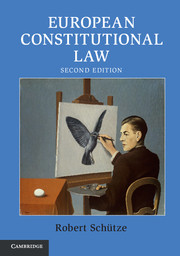Book contents
- Frontmatter
- Dedication
- Summary Contents
- Contents
- List of Illustrations
- List of Tables
- List of Cases
- List of Secondary Law
- Table of Equivalents
- List of Abbreviations
- Acknowledgements
- Introduction: European Constitutional Law
- Part I Constitutional Foundations
- Part II Governmental Powers
- Appendices
- Index
Part I - Constitutional Foundations
- Frontmatter
- Dedication
- Summary Contents
- Contents
- List of Illustrations
- List of Tables
- List of Cases
- List of Secondary Law
- Table of Equivalents
- List of Abbreviations
- Acknowledgements
- Introduction: European Constitutional Law
- Part I Constitutional Foundations
- Part II Governmental Powers
- Appendices
- Index
Summary
The European Union has existed for over half a century. It originates in the will of six European States to cooperate closer in the area of coal and steel. Since 1952, the European Union has significantly grown – both geographically and thematically. It has today 28 Member States and acts in almost all areas of modern life. Its constitutional and institutional structures have also dramatically changed in the past six decades.
The Union's remarkable constitutional evolution is discussed in Chapter 1. What type of legal ‘animal’ is the European Union? Chapter 2 analyses this question from a comparative constitutional perspective. We shall see that the Union is not a State but constitutes a ‘Federation of States’. Standing in between international and national law, the Union's federal character thereby expresses itself in a number of normative and institutional ways. Chapters 3 and 4 explore the two key normative qualities of European Union law, namely its ‘direct effect’ and its ‘supremacy’. Chapters 5 and 6 then look at the institutional structure of the European Union. Each Union institution will here be analysed as regards its composition, powers and procedures. The interplay between the various institutions in discharging the Union's governmental functions will be discussed in Part II.
1 Constitutional History: From Paris to Lisbon 3
2 Constitutional Nature: A Federation of States 43
3 European Law I: Nature – Direct Effect 77
4 European Law II: Nature – Supremacy/Pre-emption 117
5 Governmental Structure: Union Institutions I 147
6 Governmental Structure: Union Institutions II 185
- Type
- Chapter
- Information
- European Constitutional Law , pp. 1 - 2Publisher: Cambridge University PressPrint publication year: 2015



